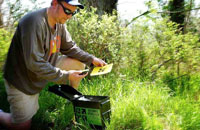The Global Positioning System (GPS) has eliminated many of the hazards associated with common recreational activities by providing a capability to determine a precise location. GPS receivers have also broadened the scope and enjoyment of outdoor activities by simplifying many of the traditional problems, such as staying on the “correct trail” or returning to the best fishing spot.
Outdoor exploration carries with it many intrinsic dangers, one of the most important of which is the potential for getting lost in unfamiliar or unsafe territory. Hikers, bicyclists, and outdoor adventurers are increasingly relying on GPS instead of traditional paper maps, compasses, or landmarks. Paper maps are often outdated, and compasses and landmarks may not provide the precise location information necessary to avoid venturing into unfamiliar areas. In addition, darkness and adverse weather conditions may also contribute to imprecise navigation results.
 GPS technology coupled with electronic mapping has helped to overcome much of the traditional hardships associated with unbounded exploration. GPS handsets allow users to safely traverse trails with the confidence of knowing precisely where they are at all times, as well as how to return to their starting point. One of the benefits is the ability to record and return to waypoints. Similarly, fishermen typically use GPS signals as a means to continually stay apprised of location, heading, bearing, speed, distance-to-go, time-to-go, chart plotting functions, and most importantly, returning to a location where the fish are plentiful.
GPS technology coupled with electronic mapping has helped to overcome much of the traditional hardships associated with unbounded exploration. GPS handsets allow users to safely traverse trails with the confidence of knowing precisely where they are at all times, as well as how to return to their starting point. One of the benefits is the ability to record and return to waypoints. Similarly, fishermen typically use GPS signals as a means to continually stay apprised of location, heading, bearing, speed, distance-to-go, time-to-go, chart plotting functions, and most importantly, returning to a location where the fish are plentiful.
An advantage in newer GPS receivers is the capability to transfer data to and from a computer. Outdoor enthusiasts can download waypoints from an exciting adventure and share them. An example of this is a web site based in Malaysia dedicated to GPS for mountain biking enthusiasts. Riders post waypoint files marking their favorite rides allowing other riders to try out the trails.
Golfers use GPS to measure precise distances within the course and improve their game. Other applications include skiing, as well as recreational aviation and boating.
 GPS technology has generated entirely new sports and outdoor activities. An example of this is geocaching, a sport which rolls a pleasurable day’s outing and a treasure hunt into one. Another new sport is geodashing, a cross-country race to a predefined GPS coordinate.
GPS technology has generated entirely new sports and outdoor activities. An example of this is geocaching, a sport which rolls a pleasurable day’s outing and a treasure hunt into one. Another new sport is geodashing, a cross-country race to a predefined GPS coordinate.
GPS modernization efforts, designed to enhance more serious applications than recreation have provided direct and indirect benefits to the user. Various GPS augmentation systems that were developed in several countries for commerce and transportation are also being widely used by outdoor enthusiasts for recreational purposes. Modernization plans for GPS will result in even greater reliability and availability for all users, such as under a denser forest cover -- just the environment in which many adventurers most need this capability.
Note: The main text of this page has not been updated since 2006.
Benefits
- Highly accurate all-weather positioning information using GPS receivers helps outdoor adventurers with safer exploration anywhere in the world.
- Ability to return to favorite fishing spots, trails, campsites or other locations with precision year after year, despite changing terrain conditions.
- New and interesting activities (based solely on the capabilities of GPS) are developed every day by outdoor enthusiasts and shared with others.
- Relatively small, portable, and affordable handsets can be used for multiple types of recreation activities.
“GPS has speeded up play on the golf course. For those in the rough, it tells them how far away they are from the trap rather than the sprinkler heads and they don't have to agonize as much over club selection if they know exactly how far they have to go. The unfortunate part is that it tells you the brutal truth of exactly how far you hit your driver. Most people think they hit it 20 or 30 yards farther than they actually do, but GPS doesn't lie.”
Bernie Friedrich, Vice President Golf Operations, Boyne, USA
 Official U.S. government information about the
Global Positioning System (GPS) and related topics
Official U.S. government information about the
Global Positioning System (GPS) and related topics





